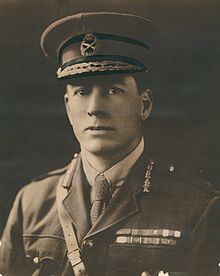Brigadier General Sir Raymond Leane CB, CMG, DSO & Bar, MC, VD, JP | |
|---|---|
 | |
| Birth name | Raymond Lionel Leane |
| Nickname(s) | The Bull |
| Born | 12 July 1878 Prospect, South Australia |
| Died | 25 June 1962 (aged 83) Adelaide, South Australia |
| Allegiance | Australia |
| Service/ | Australian Army |
| Years of service | 1905–1938, 1940–1944 |
| Rank | Brigadier General |
| Commands held | 11th Battalion (1915) 48th Battalion (1916–1918) 12th Brigade (1918–1919) 19th Brigade (1920–1921) 3rd Brigade (1921–1926) |
| Battles/wars | World War I World War II |
| Awards | Knight Bachelor Companion of the Order of the Bath Companion of the Order of St Michael and St George Distinguished Service Order & Bar Military Cross Mention in Despatches (8) Croix de guerre (France) |
| Other work | Commissioner of South Australia Police |
Brigadier General Sir Raymond Lionel Leane, CB, CMG, DSO & Bar, MC, VD, JP (12 July 1878 – 25 June 1962) was an Australian Army officer who rose to command the 48th Battalion then 12th Brigade during World War I. For his performance during the war, Leane was described by the Australian Official War Historian Charles Bean as "the foremost fighting leader" in the Australian Imperial Force (AIF), and "the head of the most famous family of soldiers in Australian history", among other accolades. After the war, he served as Commissioner of the South Australia Police from 1920 to 1944, for which he was knighted.
A businessman and part-time Citizen Forces officer before the war, Leane was commissioned into the AIF and led a company of the 11th Infantry Battalion at the landing at Anzac Cove, Gallipoli, on 25 April 1915. He rose to temporarily command his battalion, and was made a Companion of the Distinguished Service Order (DSO), awarded the Military Cross, twice mentioned in despatches and wounded three times during the Gallipoli campaign. After returning to Egypt, the AIF was re-organised, and Leane was appointed as the commanding officer of the newly formed 48th Battalion, which soon after was transported to the Western Front in France and Belgium. Important battles that the 48th were involved in under his command included the Battle of Pozières in 1916, and the First Battle of Bullecourt and First Battle of Passchendaele in 1917. During the latter battle, he was severely wounded. During 1916–1917, he was mentioned in despatches three more times, was made a Companion of the Order of St Michael and St George and awarded a bar to his DSO.
After recuperating, in early 1918 he returned to his battalion and led it during the German spring offensive of March and April 1918, which included heavy fighting near Dernancourt, for which he was again mentioned in despatches. As a battalion commander, he proved a difficult subordinate, disobeying the orders of his brigade commanders at both Pozières and Dernancourt. In June 1918 he was promoted to colonel and temporary brigadier general to command the 12th Brigade, which he led during the Battle of Amiens in August, and the fighting to capture the Hindenburg Outpost Line in September. He was mentioned in despatches a further two times after the conclusion of the war, and in early 1919 was also awarded the French Croix de guerre, and made a Companion of the Order of the Bath for his "gallant and able" leadership while commanding the 12th Brigade. During the war, four of his brothers and six of his nephews served; two brothers and two nephews were killed.
After helping oversee the repatriation of soldiers back to Australia, Leane returned home to South Australia in late 1919. In May the following year he was selected as the next Commissioner of the South Australia Police, taking up the appointment in July. His appointment was initially controversial within the force, as there had been an established practice of selecting the commissioner from within its ranks. Leane also returned to part-time soldiering, commanding at the brigade level until 1926, not without controversy. His administration of the police force was generally praised, although he did have to weather several storms, one of which involved a Royal Commission into bribery of some of his officers by bookmakers. He was a foundation member and inaugural president of the Legacy Club of Adelaide, established to assist the dependents of deceased ex-servicemen. In 1928, during a major dispute over the industrial award applying to waterfront labourers, Leane provided police protection to non-union workers, and on one occasion personally led a force of 150 police that successfully confronted a crowd of 2,000 waterside labourers who wanted to remove non-union workers from Adelaide ports. As commissioner, he introduced a number of innovations, including cadets and probationary training for young recruits, police dogs, and traffic accident analysis. After the outbreak of World War II, despite being on the retired list, Leane became the state commander of the Returned and Services League-organised Volunteer Defence Corps, a form of home guard, in addition to his duties as commissioner. After retiring in 1944, he was knighted for his services during 24 years at the head of the police force. In retirement he became involved in conservative politics, and remained active with returned servicemen's associations until his death in 1962.
© MMXXIII Rich X Search. We shall prevail. All rights reserved. Rich X Search
